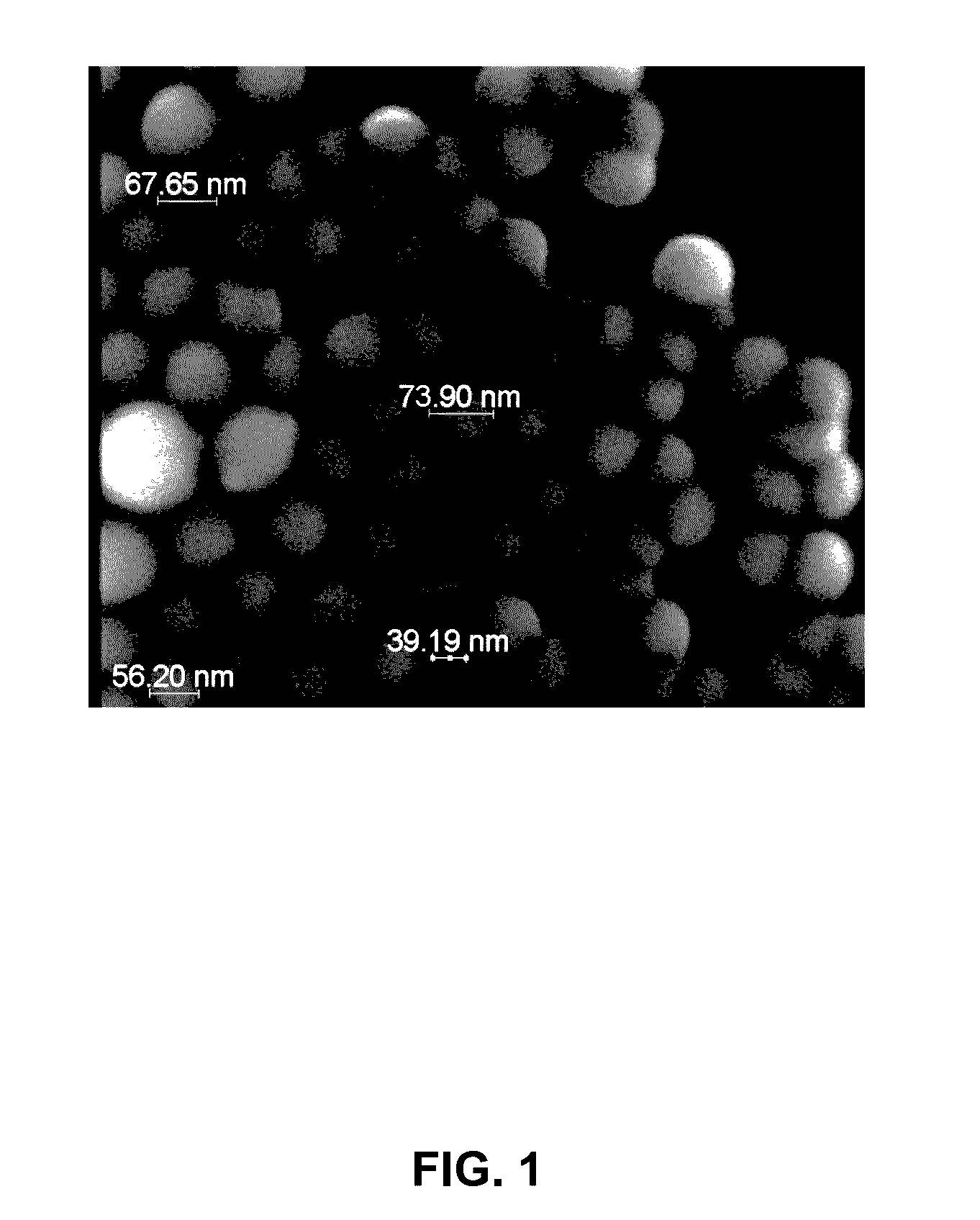Encapsulated nanocompositions for increasing hydrocarbon recovery
- Summary
- Abstract
- Description
- Claims
- Application Information
AI Technical Summary
Benefits of technology
Problems solved by technology
Method used
Image
Examples
example 1
[0047]Preparation of Nanocapsules I. In Example 1, petroleum sulfonate nanocapsules were prepared. The aqueous-based chemical was gelatin and was mixed with water to produce a 5% aqueous gelatin solution as the aqueous phase. The solvent phase was produced by mixing 100 grams (g) of iso-octane (as a solvent), 40 g of acetone (as a second solvent) and 5% Polartech® Fusion 460 (Afton Chemical, Richmond, Va.) as the source of petroleum sulfonate as the surfactant. One hundred (100) grams of the aqueous phase was heated to a temperature of 60° C. to help dissolve the gelatin, followed by the addition of 100 grams of the solvent phase and 100 grams of 20% ammonium sulfate and vigorously stirred using a magnetic stirrer for two (2) hours at 60° C. The ammonium sulfate acted a precipitating agent to aid precipitation of the gelatin from the aqueous phase. Five (5) grams of 25% glutaraldehyde (as a crosslinking agent) were then added to the mixture, and the resulting solution was allowed to...
example 2
[0048]Preparation of Nanocapsules II. In an alternative methodology, petroleum sulfonate based nanocapsules were synthesized. The solvent phase was created by initially mixing 40 grams of dibutyl sebacate (Sigma Aldrich, St. Louis, Mo.) (as the solvent), 10 grams of toluene diisocyanate (Sigma Aldrich, St. Louis, Mo.) (as the solvent-phase monomer), 12 grams of polyvinyl alcohol (Sigma Aldrich, St. Louis, Mo.) (as the solvent-phase monomer) and 10 grams of EOR2095 (Chemtura Chemicals, Philadelphia, Pa.) as a source of petroleum sulfonate (as the surfactant) in 250 ml deionized water under vigorous stirring for twenty (20) minutes at room temperature using a magnetic stirrer. 250 ml of deionized water and a 40 ml solution of 20% aqueous triethylenetetramine (TETA) (as the aqueous-phase chemical) were added to the solution. The solution temperature was then increased to 55° C. and vigorously stirred for 3 hours, resulting in a colloidal dispersion. The resulting dispersion was diluted...
example 3
[0049]Properties of Nanocapsules I. The nanocapsules of Example 2 were placed in a 90° C. oven, with the resulting petroleum sulfonate concentration recorded after 20, 48, 116, 140, 260, 468 and 596 hours (Table I) using a Mitsubishi Model NSX-2100V sulfur analyzer (Mitsubishi Corporation, New York, N.Y.). While not limiting to any particular theory or theories, it is believed that the observed increases in concentration of petroleum sulfonate over time are attributable to the increased presence of petroleum sulfonate in a continuous (non-dispersed) phase that can advantageously disperse following the injection of the nanocapsules into a subterranean reservoir or related downhole formation.
TABLE ITime dependent measurement of petroleum sulfonate concentration (inppm) in nanocapsules following heating at T = 90° C.TimePetroleum sulfonateelapsed (hours)concentration (ppm)0100720232448356011635601403560260416542852405966181
PUM
 Login to View More
Login to View More Abstract
Description
Claims
Application Information
 Login to View More
Login to View More - R&D Engineer
- R&D Manager
- IP Professional
- Industry Leading Data Capabilities
- Powerful AI technology
- Patent DNA Extraction
Browse by: Latest US Patents, China's latest patents, Technical Efficacy Thesaurus, Application Domain, Technology Topic, Popular Technical Reports.
© 2024 PatSnap. All rights reserved.Legal|Privacy policy|Modern Slavery Act Transparency Statement|Sitemap|About US| Contact US: help@patsnap.com








